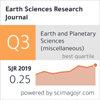Investigating the effects of groundwater level changes on GNSS observations in the Konya Closed Basin
IF 0.5
4区 地球科学
Q4 GEOSCIENCES, MULTIDISCIPLINARY
引用次数: 1
Abstract
The Konya Closed Basin (KCB) that inhabited by approximately 4 million people has a semi-arid climate and has been an important agricultural and economic production area with its alluvial fertile soils. In recent years, the use of groundwater as a main source in the intense need for irrigation in the basin due to climate change, drought and wrong agricultural policies triggered land subsidence in the basin by causing the aquifer system compaction. In this study, the effects of groundwater level changes obtained from groundwater monitoring stations on the positions of continuously operating GNSS stations located in KCB were investigated by time series analysis. As a result of trend component analyses of time series processed based on the ITRF08 fixed frame, it was determined that the horizontal positions of stations in this region were moving in the northeast direction (18.88 mm/year). For the up coordinates, while stations ANRK, KLUU, and NIGD had movements (0.56 mm/year) in the up direction, the other stations moved in the down direction. The vertical movement of KNY1 station based on 560-day data was in the down (-) direction, with an annual movement of 70.96 mm, and this was the maximum movement or velocity compared to the other stations in this region. The trend analysis of 19 wells revealed linear groundwater level changes in the down direction with a mean value of -39.22 cm/year. The decrease in the water level of the wells in the Konya Closed Basin was statistically significant for the majority of the wells and at meter level in some wells. It was determined that the linear decrease was generally caused by the reduced level of groundwater in this region. The periodic component analysis showed that the movements of the GNSS stations changed from a day to a year due to several factors, such as atmospheric and hydrological loading and climatic effects.调查科尼亚封闭盆地地下水位变化对全球导航卫星系统观测的影响
科尼亚封闭盆地(KCB)约有400万人口,气候半干旱,是一个重要的农业和经济生产区,拥有冲积肥沃的土壤。近年来,由于气候变化、干旱和错误的农业政策,地下水作为流域灌溉需求的主要来源,导致含水层系统压实,从而引发了流域地面沉降。在本研究中,通过时间序列分析研究了地下水监测站获得的地下水位变化对位于KCB的连续运行的GNSS站位置的影响。根据ITRF08固定框架处理的时间序列趋势分量分析结果,确定该地区台站的水平位置向东北方向移动(18.88毫米/年)。对于向上坐标,当ANRK、KLUU和NIGD站在向上方向上移动(0.56 mm/年)时,其他站在向下方向上移动。根据560天的数据,KNY1站的垂直移动方向为向下(-),年移动量为70.96毫米,这是与该地区其他站相比的最大移动或速度。对19口井的趋势分析显示,地下水位呈线性向下变化,平均值为-39.22厘米/年。Konya封闭盆地中大多数水井的水位下降具有统计学意义,一些水井的水位降至米级。经确定,线性下降通常是由该地区地下水水位下降引起的。周期成分分析表明,由于大气和水文负荷以及气候影响等若干因素,全球导航卫星系统台站的移动从一天变为一年。
本文章由计算机程序翻译,如有差异,请以英文原文为准。
求助全文
约1分钟内获得全文
求助全文
来源期刊

Earth Sciences Research Journal
地学-地球科学综合
CiteScore
1.50
自引率
0.00%
发文量
0
审稿时长
>12 weeks
期刊介绍:
ESRJ publishes the results from technical and scientific research on various disciplines of Earth Sciences and its interactions with several engineering applications.
Works will only be considered if not previously published anywhere else. Manuscripts must contain information derived from scientific research projects or technical developments. The ideas expressed by publishing in ESRJ are the sole responsibility of the authors.
We gladly consider manuscripts in the following subject areas:
-Geophysics: Seismology, Seismic Prospecting, Gravimetric, Magnetic and Electrical methods.
-Geology: Volcanology, Tectonics, Neotectonics, Geomorphology, Geochemistry, Geothermal Energy, ---Glaciology, Ore Geology, Environmental Geology, Geological Hazards.
-Geodesy: Geodynamics, GPS measurements applied to geological and geophysical problems.
-Basic Sciences and Computer Science applied to Geology and Geophysics.
-Meteorology and Atmospheric Sciences.
-Oceanography.
-Planetary Sciences.
-Engineering: Earthquake Engineering and Seismology Engineering, Geological Engineering, Geotechnics.
 求助内容:
求助内容: 应助结果提醒方式:
应助结果提醒方式:


